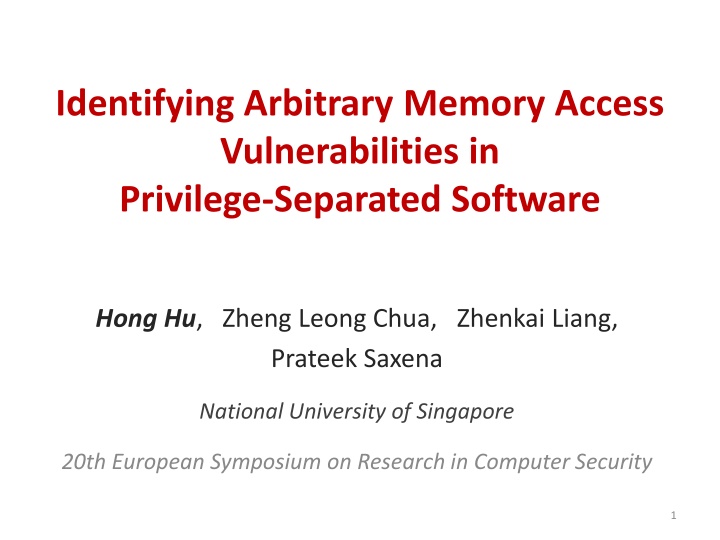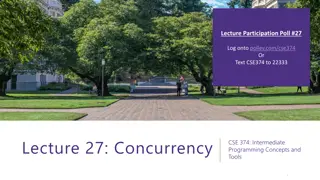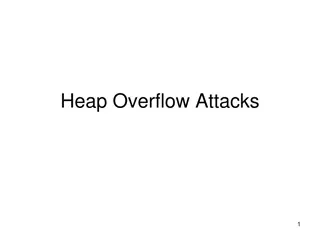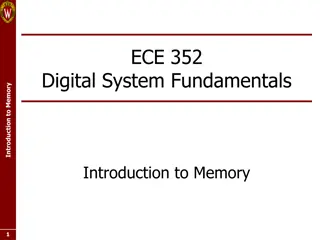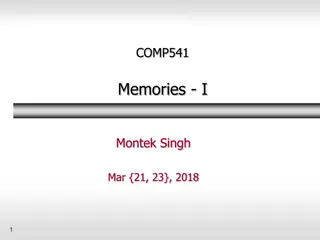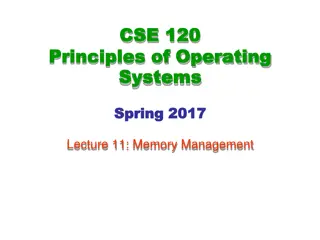Identifying Arbitrary Memory Access Vulnerabilities
This paper explores identifying arbitrary memory access vulnerabilities in privilege-separated software, emphasizing the importance of inspiration in problem-solving while highlighting the risks associated with memory access capabilities and memory isolation. It introduces the concept of privilege separation and addresses the implications of memory access on system security, presenting a systematic approach to evaluating software components individually. The discussion includes a motivating example and insights into memory write influenced by input, emphasizing the potential for attacks to bypass memory isolation.
Download Presentation

Please find below an Image/Link to download the presentation.
The content on the website is provided AS IS for your information and personal use only. It may not be sold, licensed, or shared on other websites without obtaining consent from the author.If you encounter any issues during the download, it is possible that the publisher has removed the file from their server.
You are allowed to download the files provided on this website for personal or commercial use, subject to the condition that they are used lawfully. All files are the property of their respective owners.
The content on the website is provided AS IS for your information and personal use only. It may not be sold, licensed, or shared on other websites without obtaining consent from the author.
E N D
Presentation Transcript
Identifying Arbitrary Memory Access Vulnerabilities in Privilege-Separated Software Hong Hu, Zheng Leong Chua, Zhenkai Liang, Prateek Saxena National University of Singapore 20th European Symposium on Research in Computer Security 1
Genius is 1% inspiration, 99% perspiration. But the 1% inspiration is the most important. (Thomas Edison) Out-of-context problem in human language Isolated sentences, phrases Leads to misunderstanding. Program code Out-of-context ? 2
Privilege Separation A program: set of components Partition 1 Monolithic Model JS Engine HTML Parser Browser components DOM Partition 2 Layout Engine Network AddrBar Partition 3 Privilege Separation new trust relationship memory isolation as protection enough ?
Memory Access Capability In-context capability: Capin necessary operations if( (src == src1 && dst == dst1) || (src == src2 && dst == dst2) ) memcpy(dst, src); Out-of-context capability: Capout Capin less limitation memcpy(dst, src); Capout Capin : unnecessary -> errors 4
Our Approach Systematic method evaluate each component separately JS Engine JS Engine HTML Parser HTML Parser DOM DOM Layout Engine Layout Engine Network AddrBar Network AddrBar Application on real-world isolations 5
Motivating Example struct subobj { ... } * p_sub; struct object { ... struct subobj * sub; } * p_obj; // create an object instance // and return its pointer struct object * create_object() { ... } int main() { p_obj = create_object(); p_sub = create_subobj(); p_obj->sub = p_sub; } // create a subobj instance // and return its pointer struct subobj * create_subobj() { ... } p_obj p_sub p_obj p_sub Dereference Under the Influence (DUI) memory access affected by inputs allow attacks to bypass memory isolation 6
Write DUI Memory write influenced by input memory write address depends on inputs value depends on inputs, or deterministic 1 v1 = API_recv(); 2 v2 = API_recv(); 3 array[v1] = v2; 1 v1 = API_recv(); 2 v2 = 0; 3 array[v1] = v2; corrupt control data / non-control data e.g., return address, function pointer, user id 7
Read DUI Memory read influenced by input memory read address depends on inputs retrieved value is sent out 1 v1 = API_recv(); 2 data = array[v1]; 3 API_send(data); leak sensitive information e.g., password, private key e.g., stack canary, randomized address, CFI tags 8
DUI Detector Suspicious instruction shortlisting suspicious instruction shortlist execution state Execution state collection Dereference behavior analysis execution state Input: Protected components & Sample inputs Output DUI vulnerability & severity 9
Suspicious Inst. Shortlisting Data dependency analysis to track input Write DUI detection Memory writing instruction Tainted/fixed src operand Tainted base/index address of the dst operand mov %eax, (%esi) add %ebx, (%esi, %ecx, 2) 10
Suspicious Inst. Shortlisting Data dependency analysis to track input Read DUI detection Memory read operation Tainted base/index address of the src operand Result is used at sinks e.g., send(), cross-partition call/return, etc mov (%esi), %eax sink(%eax) 11
Dereference Behavior Analysis off = API_recv(); value = API_recv(); addr = base + off; if (addr < MAX_ADDR) *addr = value + 100; value = random(); data flow constraint control flow constraint memory space constraint data flow constraint life-cycle constraint Capture constraints on inputs data flow constraints control flow constraints memory space constraints data life-cycle constraints Dereference constraints 12
Dereference Behavior Analysis Attacker s memory access capability Cap small |Cap| ==> almost non-exploitable larger |Cap| ==> more severe Cap Estimation initial target analysis memory space constraints (R/W permission) bit pattern analysis e.g., address & 0x11 == 0x01 range analysis e.g., / address Range sat Dereference constraints SMT solver Sat? 13
Implementation (1) Taint Propagation fine-gained taint record propagation add %eax, %ebx T_source(%ebx) = T_source(%eax) T_source(%ebx) 1-level table lookup mov (%esi), %eax mov (%eax), %eax mov (%esi), %eax mov (%eax), %eax Enable False positive Disable mov (%esi), %eax mov (%eax), %eax mov (%esi), %eax mov (%eax), %eax False negative 14
Implementation (2) Constraints capture memory space constraint log module loading/unloading event malloc, free restore memory layout for each instruction data life-cycle constraint next instruction update a location 15
Evaluation Isolation schemes user/kernel isolation (e.g., overshadow) User Space Program glibc glibc Kernel syscall main-code/library isolation (e.g., codejail) lib1 Main program lib2 lib3 libcall 16
Write DUI in user/kernel Isolation glibc code handling brk() 1 addr1 = brk(0); 2 addr2 = brk(argument); 3 *(addr1 + 4) = addr2 - addr1; 1 mov %eax, 0x4(%edx) 2 ... 3 mov %eax, 0x4(%edi); setup heap region line 1: overwritten immediately (|cap| = 0) line 3: write DUI condition( brk1%8 == 0 && brk2 > brk1 ) address = brk1 + 0x2718 data = (brk2 - address) | 0x1 17
Write DUI in user/kernel Isolation Other paths condition(brk1%8 != 0 && brk1<brk2<brk3) address : relies on brk1; data : relies on brk1 and brk2; condition(brk1%8 != 0 && brk1<brk2>brk3) Iago* address : relies on brk1; data : relies on brk1 and brk3; Systematic method vs manual analysis glibc code handling mmap2() *Stephen Checkoway and Hovav Shacham. Iago attacks: why the system call API is a bad untrusted RPC interface. In ASPLOS 2013. 18
Read DUI in user/kernel Isolation cat code handling read()/write() 1 nr = read(rfd, buf, size); 2 for (off = 0; nr; nr -= nw, off += nw) { 3 nw = write(wfd, buf + off, nr); 4 if (nw == 0 || nw == -1) 5 goto error; 6 } Pass by copy use memory kernel memory secret Public memory buf + off shared 19
Write DUI in main-code/library Isolation Programs Using libsdl 1 screen = SDL_SetVideoMode(...); // get framebuffer surface 2 color = SDL_MapRGB(...); // get a pixel value 3 pixmem16 = screen->pixels + x + y * pixelsperline ; 4 // get pixel address 5 *pixmem16 = color; // set the color write DUI one line 5 no limitation on attackers 20
Conclusion Privilege separation leaves memory errors Dereference Under the Influence (DUI) DUI Detector systematic way to detect DUI Application user/kernel isolation, library isolation write/read DUIs 21
Thanks! Hong Hu huhong@comp.nus.edu.sg http://www.comp.nus.edu.sg/~huhong/ 22
Performance Solving formula 120 Access formula generation 100 Trace generation 80 60 40 20 7574.23 0 glibc_brk glibc_mmap2 cat main_libsdl DUIs are detected within several minutes Trace generation takes most of the time Depends on the trace size 23
